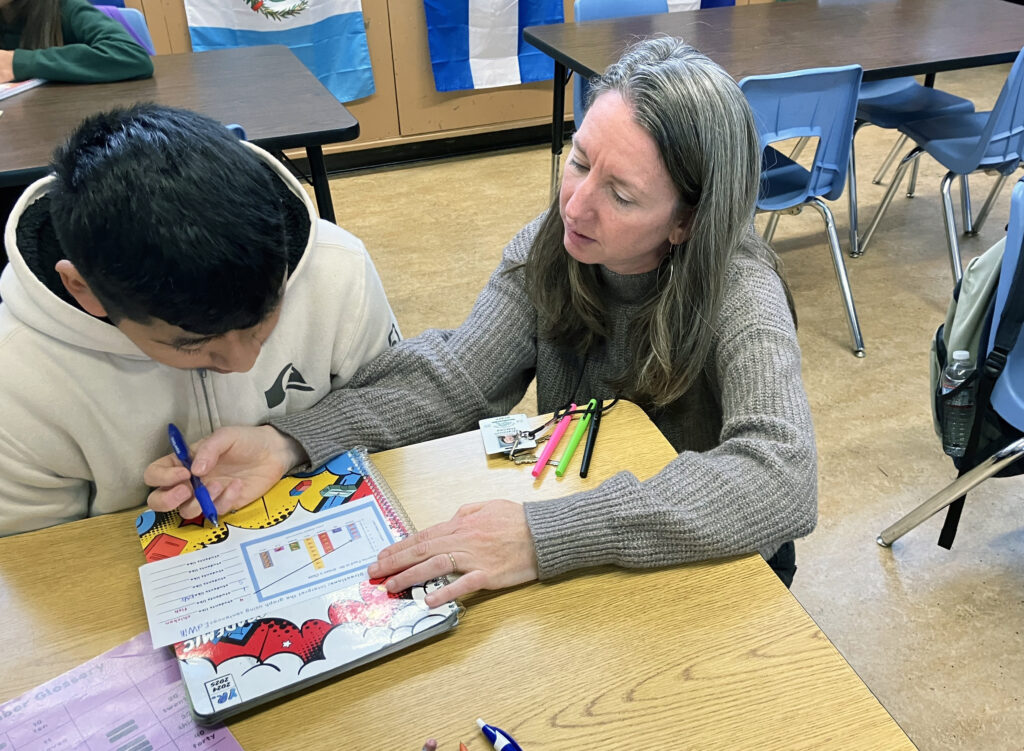Teacher Shannon Darcey helps a student interpret a graph.
Zaidee Stavely / EdSource
Este artículo está disponible en Español. Léelo en español.
In her home country of Guatemala, Maribel attended a one-room schoolhouse for two years, but the teacher was often absent, causing class to be canceled. She never learned how to read. The school closed during Covid, and she never returned to class until last year, when she moved to Oakland.
Now 11 and enrolled in middle school, she is learning English and at the same time filling gaps in her education — how to read, interpret graphs and acquire other skills she never learned before.
Maribel’s school, Urban Promise Academy, is one of four middle and high schools in Oakland trying out a new curriculum developed just for students who did not attend school for years in their home countries. School staff asked EdSource to only use middle names to identify students because they are recent immigrants. There is heightened fear among immigrant students and families because of the Trump administration’s promises to ramp up immigration enforcement.

In Maribel’s classroom, though, no fear was palpable. Instead, there was joy.
On one recent morning in her English class, Maribel and her peers were analyzing graphs showing favorite colors, favorite foods, favorite sports and home languages among students in a class. They were practicing marking the x-axis and y-axis, pronouncing numbers in English and talking about what the graphs meant.
“How many students like pizza?” asked teacher Shannon Darcey.
“Eight students like pizza,” responded a student.

About 3,300 students in Oakland Unified this school year — close to 10% of the total student population — immigrated from other countries in the last three years. Of those, at least 600 had more than two years in which they did not attend school in their home countries. These students are often referred to as students with interrupted formal education, or SIFE.
The reasons students missed school vary. Some lived in rural communities far from schools, for example. For others, it was dangerous to attend school because of gang violence or war in their communities. Other students simply had to work.
When students haven’t yet mastered academic reading, writing, or math in their home language, they have a lot more to learn in order to grasp middle or high-school level material, even as they are learning English. But if the materials or curriculum are designed for younger students, it can be boring or seem too childish for teenagers.
Before this school year, Darcey taught English to recent immigrant students with a huge range of academic knowledge. Some students were reading at seventh or eighth grade level in Spanish, for example, while others could not read at all. She remembers some students being frustrated.
“I had one kid … Every single day for six months, he was like, ‘I can’t read. Why are you giving me this?’” Darcey said. “He felt like, ‘Everyone else in here knows what is happening, and I have no idea what this is. Why are you telling me to have a book in my hands?’”
For years, Darcey tried to access curriculum designed especially for students who have had big gaps in schooling. She had heard about a curriculum called Bridges, developed by researchers at the Graduate Center at the City University of New York. But when she tried to get materials from them, she was told they were only available for teachers in New York.
Julie Kessler, director of newcomer and English language learner programs in Oakland Unified, said many teachers she has worked with in Oakland Unified and San Francisco Unified were frustrated at not being able to access the Bridges curriculum.
“And so it’s like, who’s got a bootleg copy of it?” Kessler said. “And it’s just been inaccessible to the field.”
She said she has often seen students with big gaps in schooling disengaged in class.
“They are experiencing sometimes an alternate assignment, sometimes sitting with like a Disney book or a children’s book, when even the scaffolded newcomer curriculum is inaccessible to them,” Kessler said. “We were seeing a lot of that because teachers didn’t have a way to connect them to what was happening.”
Last year, though, Kessler was able to secure funding from the California Department of Social Services’ California Newcomer Education and Well-Being program, to develop a new curriculum considering the needs of Oakland’s newcomer population and aligned to the California English Language Development standards. She worked with some of the authors of the Bridges curriculum, who now have an organization called the SIFE Equity Project.
The resulting Curriculum for SIFE Equity is open source, available to all teachers anywhere on the internet. And Kessler said there are teachers in San Rafael, Elk Grove, San Diego and Vista using it, in addition to Oakland. Outside of California, the curriculum is also being used in New York City and Prince William County, Virginia.
“We’re hearing a lot of gratitude from teachers who are like, ‘Oh my God, finally something that I can use with this group of students that feels worthy of their time, that feels respectful of them and feels like it’s doing the skill building that we know that they need,’” Kessler said.
The curriculum currently includes about 50 days of instruction — less than a third of a school year. Kessler said the district is now trying to get more funding from the Department of Social Services to develop a full 180 days, so it can be used for a full school year.
Darcey said the curriculum has made a huge difference. She now has separate English classes just for students who have gaps in their education.

The class began the school year with a unit on identity. Studens learned how to say their names, how old they are, where they are from, what language they speak. They later put together “identity maps” with their name in the middle, and information about their hometowns, their ages, their responsibilities, families and what they like to eat and do for fun written in spokes all around. Then they created slideshows with the information and added photos.
Fourteen-year-old Anallely’s map shows that she likes salad, fish and marimba music, that she speaks the indigenous language Mam in addition to Spanish, and her hometown is in the mountains and forest of Guatemala, where it is hot and rainy.
Anallely only attended school in her hometown until third grade. After that, she stopped going so she could work with her father, planting and harvesting coffee on a farm.
She said she had never learned about graphs or maps to organize information before coming to school in Oakland.
“It’s very useful, because you can use them to define how many people like something or which is their favorite, or where they are from,” she said in Spanish.
She hopes to someday become a doctor to help babies and people who are sick. She’d also like to travel the world.
Most of Darcey’s students are new to reading in any language, so Darcey also works with them in small groups to teach them letter sounds, and how to sound out syllables and one-syllable words like tap, nap and sat, using a curriculum called UFLI Foundations, adapted for recent immigrant students by teachers at Oakland International High School.

Another student, Arturo, never attended school in his life until he enrolled at Urban Promise Academy at 14 years old.
“In previous years, a kid like that in my class, I would’ve felt like, ‘Oh my God, they’re like totally lost, and it feels like they’re just sitting there 80% of the time,’” Darcey said. But she doesn’t feel that way about Arturo. “He is engaged, he’s trying. Can he read the words on the page yet? No. But he’s still able to follow what’s happening.”
Darcey is grateful to work with these students.
“They bring such an eagerness and excitement, a willingness to try new things that maybe other kids their age are not as enthusiastic about,” Darcey said. “They often bring a work ethic that I think can really help a lot of them be successful in school.”
Giving these students skills to navigate the world is important, Darcey said, because they are already part of our society.
“We’re going to prepare them to be successful in their lives,” she said.
Maribel, the student who only attended two years of school in Guatemala, said she was afraid to come to school in the U.S. at first, but now she looks forward to it.
“The teacher speaks some Spanish and she always helps us if we need anything,” Maribel said. “I can write some words in English now, and I’m writing more in Spanish, too. And I’m learning to read.”
A previous version of this article incorrectly named the literacy curriculum Darcey uses as SIPPS. She uses UFLI Foundations.

